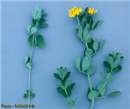Scientific name(s)
Lotus pedunculatus (Lotus uliginosus)
Strengths
- Perennial legume, adapted to very waterlogged soils and low pH soils.
- Spreads by rhizomes and is non-bloating.
Limitations
- Seedling establishment is slow.
- Needs moist conditions to assist with summer persistence.
Plant description
Plant: Perennial herbaceous with stolons and shallow rhizomes with a crown located under the soil surface. Herbaceous, erect to prostrate growth habit, with growth mostly over summer.
Stems: Stems are usually hollow to 80 cm long.
Leaves: Leaves are usually hair-less, 4-25 mm long and 3-15 mm wide and occur as five leaflets (pentafoliate), three terminal and two basal. Basal leaflets are often mistaken as stipules.
Flowers: Flowers occur as an umbel in groups of 5 to 12 (-15). Corolla is yellow, often but not always with red veins.
Pods: Pods are straight, long cylindrical in shape 15 to 40 mm in length and shatter to disperse seed as they dry.
Seeds: Seeds are greenie yellow to brown about 0.9 mm long (2 x 106 seeds/kg).
Pasture type and use
Greater Lotus is growing in coastal areas of Australia or in high rainfall subtropical areas. It is also very tolerant of waterlogging and acid soils. Greater Lotus is also grown in combination with Kikuyu or Paspalum and is suitable for cattle or sheep.
Where it grows
Rainfall
> 900 mm average annual rainfall
Soils
Suited to a wide range of soils particularly infertile soils.
Temperature
Cold and frost tolerant.
Establishment
Companion species
Compatible with grasses such as Kikuyu and Paspalum.Compatible with legumes such as strawberry clover.
Sowing/planting rates as single species
3 to 6 kg/ha (not commonly sown by itself)
Sowing/planting rates in mixtures
1 to 3 kg/ha
Sowing time
Autumn or spring sowing with careful management of weeds. Previously established pasture species should be grazed pre and post sowing. Sowing depth is best at 0.5 to 1 cm into a firm, level seedbed.
Inoculation
Special Lotus pedunculatus inoculant.
Fertiliser
Phosphorus and any other nutrients required to avoid deficiencies.
Management
Maintenance fertliser
Olsen P soil test for phosphorus above 12
Grazing/cutting
Establishing stands should be allowed to reach 10% flowering before light grazing is applied. Grazing in subsequent years can be much harder however some leaf area should be left after each grazing. Greater Lotus is more tolerant of grazing than Lotus corniculatus.Under grazing can be a problem where companion grass species reduce light.
Seed production
Seed crops should be cut or grazed to about 10 cm before locking the paddock up for flowering. Irrigation is needed to ensure that stands do not undergo moisture stress during seed-set. Seed yields range from about 100 kg/ha to 400 kg/ha depending on the variety environment and management.
Ability to spread
Spreads primarily via rhizomes.
Weed potential
Medium as it can spread via rhizomes and seed, although its area of adaptation in Australia is much smaller than that of Lotus corniculatus.
Major pests
Heliothis caterpillars are the major insect problems in Australia.
Major diseases
-
Herbicide susceptibility
Susceptible to broadleaf hormone herbicides and benazolin based herbicides at the seedling stage. Grass selective herbicides present no phytotoxic problems.
Animal production
Feeding value
Dry matter digestibility 65 to 75%, Crude protein 18 to 25%.
Palatability
Tannins are between 4 and 12% of dry weight. Tannin levels above 7% may impact on intake in monoculture stands.
Production potential
Dry matter production is commonly in the order of 3 to 9 t/ha.
Livestock disorders/toxicity
Can produce cyanogenic glucosides however levels of production are very unlikely to cause cyanide poisoning.
Cultivars
| Cultivar | Seed source/Information |
| Sharnae | Australian Herbage Plant CultivarsContact local seed merchant for seed |
| Grasslands Maku | Contact local seed merchant for seed |
| Grasslands Sunrise | Contact local seed merchant for seed |
Further information
Contact Graeme Sandral at NSW Department of Primary Industries or Daniel Real at the Department of Food & Agriculture WA.
Acknowledgements
Livestock disorders provided by Dr Chris Bouke, Principal Research Scientist, NSW Department of Primary Industries.
Author and date
Graeme Sandral, Daniel Real and Dmitry Sokoloff
January 2009




